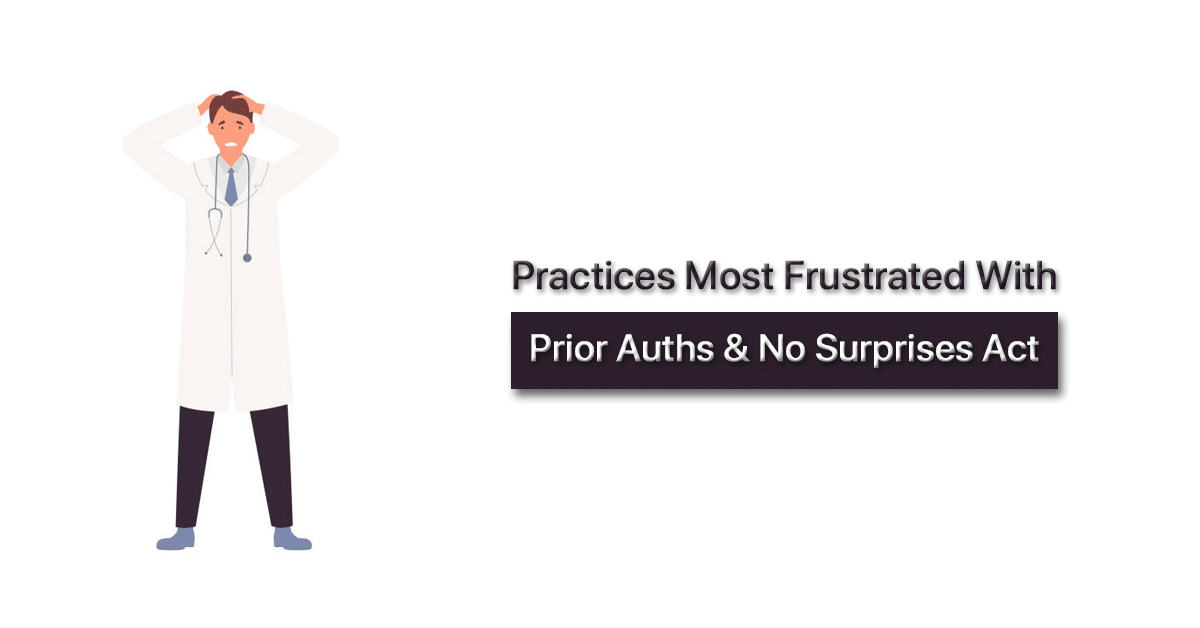Regulatory burden is on the rise yet again as practices struggle with prior authorizations, No Surprises Act compliance, and the Quality Payment Program, MGMA reports.
Prior authorizations are still the top regulatory burden according to executives from group practices, while No Surprises Act compliance has debuted on the list this year as the second most burdensome regulatory.
Those are the findings from MGMA’s 2022 Annual Regulatory Burden Report, a survey of executives from over 500 group practices. Of the practices responding this year, more than three-quarters are independent and about 64 percent have less than 20 physicians. Fifteen percent are practices with over 100 physicians.
Yet again, group practice leaders say they are facing more regulatory burden compared to last year. In the 2022 report, 89 percent of respondents said regulatory burden on their practice has increased over the last 12 months. That is down just slightly from 91 percent in the 2021 report.
Meanwhile, less than one percent of respondents said regulatory burden has decreased and 11 percent said it has not changed.
Compliance with health policies and regulations is a major challenge for medical practices and one that can detract from patient care, MGMA says. An overwhelming majority of group practice executives (97 percent) agreed that a reduction in regulatory burden would allow their practices to reallocate resources toward patient care.
Some executives added that staffing shortages are making compliance even more burdensome while increasing costs coupled with decreasing reimbursement rates mean there are no resources available to put toward regulatory issues.
In a time of runaway inflation and unprecedented workforce shortages, the federal government is layering on additional regulatory burdens that, while in theory are beneficial to patients, act more as an impediment to delivering care.
From longstanding challenges associated with the Quality Payment Program, to new obstacles related to the No Surprises Act, it is evident that policymakers must consider the totality of these burdens and their ultimate impact on patient care.
Prior authorizations still ranked as the top burdensome regulatory issue, with nearly 82 percent of practice executives rating it as very or extremely burdensome. Twelve percent said it was moderately burdensome and 4 percent said they were slightly burdensome. Just 2 percent said prior authorizations were not burdensome at all.
Prior authorizations have held steady as the top regulatory burden for the past couple of years, even beating out COVID-19 workplace mandates last year. There’s a good reason, too. The American Medical Association (AMA) reports that physicians complete an average of 41 prior authorizations each week and spend an average of two business days on the processes. Forty percent of physicians have staff who exclusively complete prior authorizations.
MGMA also found that 89 percent of practices have hired or redistributed staff to work on prior authorizations due to the increase in requirements.
However, new surprise billing rules are giving prior authorizations a run for their money.
The No Surprises Act went into effect this year, prohibiting providers from unexpectedly balance billing patients when their insurance does not pay for out-of-network care. The law was designed to protect healthcare consumers from these surprise medical bills, which tend to impose a financial burden.
However, complying with the policies and regulations implementing the No Surprises Act is also burdening group practices. In particular, providers are struggling to give “good faith estimates,” or price quotes for all expected charges to self-pay and uninsured patients.
Approximately 70 percent of executives rated surprise billing and good faith estimate requirements as very or extremely burdensome, while 18 percent said they were moderately burdensome. Over 8 percent said the requirements were slightly burdensome and about 2 percent said they were not burdensome.
Good faith estimate requirements and other rules have already been out for months, yet 78 percent of those surveyed by MGMA still require additional guidance from CMS to fully understand the good faith estimate process.
Furthermore, MGMA polled executives on whether their practices have the technical infrastructure to comply with convening or co-provider requirements starting next year. Nearly three-quarters said they do not have the infrastructure, indicating an ongoing regulatory burden for practices.
Rounding out the top five most burdensome regulatory issues in 2022 are Medicare’s Quality Payment Program (64 percent said it was very or extremely burdensome), audits and appeals (63 percent), and Medicare Advantage chart audits (60 percent).
Other regulatory issues addressed in the report included translation and interpretation requirements, lack of EHR interoperability, COVID-19 Provider Relief Fund reporting requirements, and Medicare and Medicaid credentialing.
For More Information: practices most frustrated with prior auths then no surprises act

